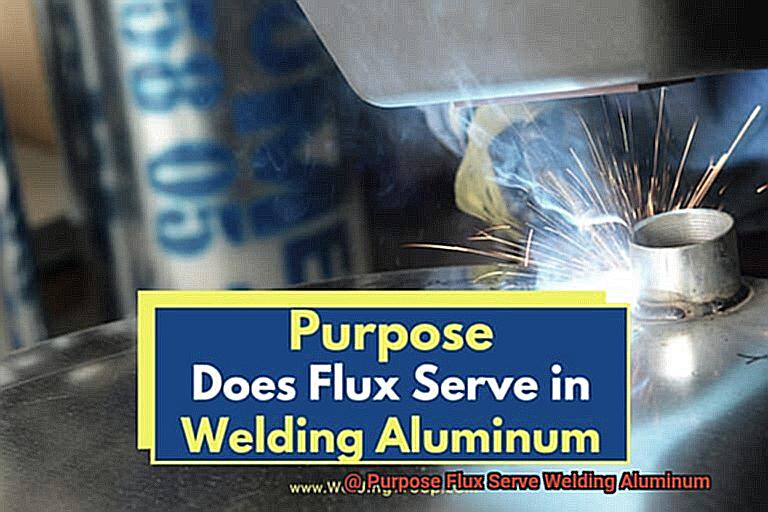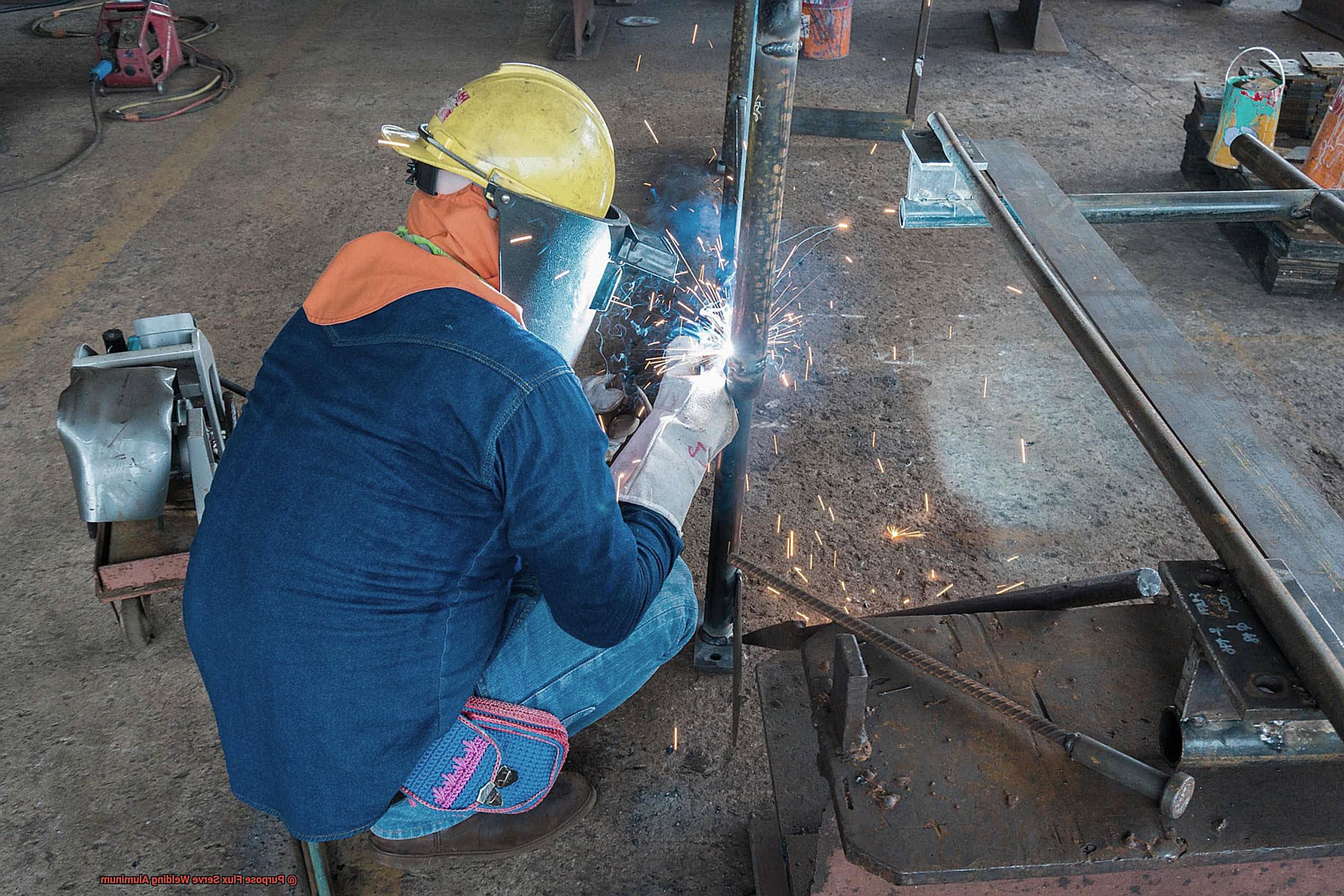Welcome to our blog post delving into the intriguing realm of flux serve welding aluminum.
If you’re a part of the welding industry, chances are you’ve come across this technique, but do you truly comprehend its intricacies? Fret not, as we have all the answers for you.
Flux serve welding aluminum is a specialized method that involves utilizing a flux-cored wire to fuse two pieces of aluminum together. However, why opt for this approach over conventional methods like TIG or MIG welding?
And how does it function exactly? Join us as we unravel these mysteries and more while exploring the purpose and process of flux serve welding aluminum.
So, grab your protective equipment and let’s embark on this journey together.
What Is Welding Flux
Contents
- 1 What Is Welding Flux
- 2 Why Is It Used
- 3 What Are The Types Of Welding Flux
- 4 Composition Of Welding Flux
- 5 Functions Of Welding Flux
- 6 Advantages And Disadvantages
- 7 What Is The Function Of Flux In Submerged Arc Welding
- 8 To Which Types Of Welding Do Flux Applied
- 9 Unleashing the Mighty Force of Flux in Aluminum Welding
In the world of welding, there exists a term that may seem strange to those not well-versed in the craft: flux. This seemingly insignificant component plays a vital role in the process of welding aluminum, a metal highly susceptible to oxidation and contamination during welding. In this piece, we will delve into the complexities of welding flux and its crucial role in protecting against these potential hazards.
As mentioned, aluminum is a finicky metal that can easily succumb to oxidation and contamination from gases like hydrogen and moisture during the welding process. These unwelcome elements can result in porosity and defects in the weld, compromising its strength and integrity. This is where welding flux comes into play. When exposed to high temperatures, flux creates a barrier between the molten weld and the surrounding air, thwarting any chance of oxidation. It also absorbs any moisture present in the atmosphere, ensuring a clean and smooth weld.
But that’s not all – welding flux also serves another pivotal purpose: slag formation and gas shielding. As the molten weld cools, the flux forms a protective layer called slag over it, shielding it from atmospheric gases like oxygen and nitrogen. This is especially crucial when working with aluminum, which has a low melting point and can easily react with oxygen to form oxides. The gas shield created by flux also helps maintain a stable arc, making it easier to control the weld pool and produce high-quality results.
There are four main types of welding flux: rutile, basic, cellulosic, and submerged arc. Each type has its own unique characteristics and uses. For instance, rutile flux is commonly used for welding thin sheets of aluminum due to its low hydrogen content. On the other hand, basic flux is better suited for thicker plates as it produces a more fluid slag that can easily penetrate through deep grooves. Cellulosic flux is ideal for welding vertical joints as it creates a thick slag that prevents the molten weld from dripping.
Why Is It Used
The use of flux in welding aluminum may seem puzzling at first glance. After all, aluminum is renowned for its lightweight and resistant nature, so why does it require additional safeguarding during the welding process? The answer lies in the intricate composition and properties of aluminum, coupled with the formidable hurdles it presents during welding.
Firstly, aluminum is an exceedingly reactive metal that readily oxidizes upon exposure to air. Consequently, when subjected to the intense heat of welding, it reacts with the oxygen in the air and forms an oxide layer on its surface. This impedes the formation of a robust weld. Moreover, due to its high conductivity, aluminum has a propensity for attracting moisture and hydrogen from the atmosphere. These elements can lead to the formation of porosity and other defects in the weld.
Enter flux. Acting as a barrier between the molten weld and air, flux prevents oxidation and contamination from occurring. It creates a protective slag and gas shield that envelops the weld pool, effectively shielding it from any external influences such as air or moisture. This enables the formation of a clean and superior quality weld, devoid of any unwanted imperfections.
However, not all fluxes are cut from the same cloth. There exist four main types of flux used in welding aluminum: rutile, basic, cellulosic, and submerged arc. Each type boasts unique properties that make them suitable for various welding applications. For instance, rutile flux is known for its versatility and works exceptionally well on thin materials, while basic flux provides unparalleled protection against moisture and hydrogen.
In addition to serving as a barrier and gas shield, flux also plays a vital role in stabilizing the welding arc. It interacts with the weld pool, rendering the metal cleaner and more manageable. This results in a stronger and more precise weld.
In conclusion, the use of flux in welding aluminum is essential to overcome the challenges posed by this reactive metal.
What Are The Types Of Welding Flux
Welding flux may seem like a perplexing term, but its role in the welding process is vital. For those unfamiliar with welding, flux is a chemical agent that protects the molten weld pool from contamination and promotes the formation of strong and clean welds. In simpler terms, welding flux acts as a protective shield for your weld, ensuring a burst of smooth and immaculate results.
When it comes to welding aluminum, selecting the right type of welding flux is crucial. There are various varieties of welding flux available, each with their own unique properties and benefits. Let’s delve into the different types of welding flux and their uses.
Acidic Fluxes
These fluxes contain hydrochloric or hydrofluoric acid, which effectively removes oxides from the surface of the metal. They are highly proficient in cleaning aluminum surfaces and promoting better adhesion of the weld. However, due to their corrosive nature, they require careful handling.
Alkaline Fluxes
Alkaline fluxes are composed of alkaline compounds such as sodium or potassium hydroxide. They are less aggressive than acidic fluxes and are often used for welding thin aluminum sheets. Additionally, they have a lower melting point, making it easier to remove them after welding.
Salt-Based Fluxes
These fluxes are created from a mixture of metallic salts such as potassium chloride, sodium chloride, and ammonium chloride. They have excellent deoxidizing abilities and efficiently remove impurities from the surface of aluminum. However, they do leave behind a residue that must be meticulously cleaned after welding.
Non-Corrosive Fluxes
Non-corrosive fluxes are specially formulated to be gentle on metal while still providing effective cleaning and deoxidizing properties. These fluxes typically consist of organic compounds and do not contain any acidic or alkaline ingredients. They are ideal for use on delicate or highly reactive metals like aluminum.
Composition Of Welding Flux
Welding is an essential process in the realm of fabrication and manufacturing, enabling us to construct sturdy and enduring structures by joining metal pieces together. However, without the use of flux, welding would not be feasible. Flux plays a vital role in the welding process, functioning as a protective barrier to ensure immaculate and high-quality welds. In this blog article, we will delve into the composition of welding flux and its significance in various welding techniques.
What is Welding Flux?
Welding flux is a chemical compound utilized in welding to safeguard the weld pool from atmospheric pollutants and prohibit oxidation. It typically comprises metal oxides, carbonates, and fluorides, each serving a distinct purpose in the welding process.
The Significance of Flux in Welding
Flux has multiple key roles in welding, rendering it an indispensable element in the process. Firstly, it acts as a purifying agent, eliminating impurities such as grime, oil, and corrosion from the metal surface. This ensures a spotless weld with minimal imperfections.
Secondly, flux aids in controlling the shape of the weld bead by regulating its width and depth. This is particularly critical when welding dense materials or performing overhead welds.
Moreover, flux stabilizes the welding arc by regulating its temperature and preventing it from wandering or flickering. This results in a seamless and consistent weld with no flaws.
Lastly, flux creates a protective layer of slag over the weld, shielding it from atmospheric gases like oxygen and nitrogen. This prevents oxidation and guarantees a robust and enduring weld.
Functions Of Welding Flux
Among these indispensable tools is welding flux, a material with a critical role in safeguarding aluminum from oxidation and air pollution. As a welding specialist, allow me to reveal the vital functions of welding flux and its crucial role in producing impeccable and top-notch welds.
Defence against oxidation and air pollution:
When it comes to welding aluminum, one of the greatest obstacles is preventing oxidation and air contamination during the welding process. Aluminum is highly vulnerable to porosity and defects caused by contaminated welds. This is where welding flux comes into play, acting as a barrier between the molten weld and the atmosphere. It creates a safeguarding layer or slag that shields the weld from any contact with the surrounding air.
Purifying agent:
In addition to protecting against atmospheric contamination, flux also serves as a purifying agent. It interacts with the weld pool, eliminating any impurities and ensuring a pristine weld. This is particularly crucial when welding aluminum, as impurities can weaken the weld and lead to structural issues.
Stabilizing force:
Another significant function of welding flux is its ability to stabilize the arc during welding. A stable arc is necessary for producing high-quality welds, and flux aids in achieving this by providing a consistent gas shield around the weld. This gas shield maintains an optimal environment for welding, preventing any disruptions or fluctuations that could jeopardize the integrity of the weld.
Diverse types of flux for various applications:
There are several types of welding flux available, each designed for specific applications. For instance, there are fluxes for TIG welding, MIG welding, and stick welding. Each type of flux possesses unique properties that make it suitable for different welding techniques and materials.
To sum it up, welding flux plays an indispensable role in the art of welding, especially when dealing with aluminum.
Advantages And Disadvantages
Welding, a vital process in the construction and repair of metal structures, has widely incorporated the use of flux. Flux plays a crucial role in welding, offering various advantages to the welds. However, like any other welding technique, there are also some drawbacks to using flux. In this blog post, we will delve into both the merits and demerits of utilizing flux in welding.
Advantages:
Protection from Atmospheric Contamination
One of the primary functions of flux is to act as a shield, safeguarding the weld pool from atmospheric contamination. When exposed to air, the molten metal can react with oxygen and other gases, resulting in oxidation and weakening of the weld. Flux creates a protective layer over the weld pool, preventing any contact with air and ensuring a clean and robust weld.
Elimination of Impurities
Flux also aids in eliminating impurities from the welding surface, producing cleaner and stronger welds. These impurities may include dirt, rust, oil, and other contaminants that can compromise the quality of the weld. By utilizing flux, these impurities are entrapped in the slag generated by the flux, leaving behind a pristine surface for the weld to bond correctly.
Stabilization of Welding Arc
Another advantage of utilizing flux is its capacity to stabilize the welding arc. The flux coating on the electrode creates a more controlled and stable arc, making it easier for the welder to manipulate and produce high-quality welds.
Protective Coating
The slag formed by flux acts as a protective coating for the weld. It creates a barrier between the molten metal and external contaminants such as air, moisture, and dirt. This protective coating enhances the structural integrity of the weld and makes it more resistant to corrosion.

Surface Preparation
Flux can also be applied before welding to prepare the surface and ensure proper adhesion.
What Is The Function Of Flux In Submerged Arc Welding
Flux, the unsung hero of submerged arc welding, is a vital element in achieving top-notch welds. This often disregarded substance plays a pivotal role in safeguarding the weld pool from air and impurities, slowing down the cooling rate of the weld metal, and reaching high deposition rates. But what exactly is flux and how does it function in submerged arc welding? Let’s delve deeper into this subject.
First things first, what is flux? Flux is a granular material utilized in welding processes to shield the weld pool from atmospheric contaminants and assist in producing a high-quality weld. It acts as a barrier between the weld and the surrounding air, preventing any impurities from infiltrating the weld pool. But that’s not all – flux also serves other critical functions that contribute to the triumph of submerged arc welding.
One of the primary roles of flux is to diminish the cooling rate of the weld metal. When a weld cools too quickly, it can result in cracks and other imperfections. Flux helps decelerate the cooling process, allowing the weld to solidify at a more controlled pace, resulting in a sturdier and more long-lasting weld.
Another crucial function of flux is to achieve elevated deposition rates. Deposition refers to the volume of filler metal deposited onto the base material during welding. Flux plays a vital role in increasing deposition rates, which ultimately leads to quicker and more efficient welding.
In addition to its protective and cooling functions, flux also aids in producing the type of exceptional weld commonly seen in submerged arc welding. The flux creates a slag layer over the welded area, which not only shields the weld pool from contamination but also helps shape the weld bead. This slag layer protects the hot metal from atmospheric gases, allowing it to cool gradually and uniformly, resulting in a sleek and immaculate weld.
Lastly, flux also assists in stabilizing the welding arc and initiating an initial arc strike during welding.
To Which Types Of Welding Do Flux Applied
Welding is an intriguing process that involves melding different metals together to form robust and long-lasting structures. However, there is a secret element that amplifies the effectiveness of welding, known as flux. This mysterious ingredient plays a vital role in the welding process and varies in forms, functions, and uses.
But what exactly is flux? It can be described as a chemical cleaner, flow enhancer, or purifying agent that facilitates the fusion of metals during welding. Its primary purpose is to preserve the integrity of the weld by preventing elements like oxidation, sulphides, and nitrides from weakening it. As an integral component in metallurgy and metal joining, flux is essential in ensuring the strength and durability of welded structures.
Now, let’s delve into the four main types of flux used in welding. First on the list is basic flux, known for its high resistance to extreme temperatures and ability to reduce impurities in the weld. Next is rutile flux, commonly used in gas shielded wires due to its user-friendly nature. Then there’s iron oxide flux, ideal for stick welding as it produces minimal spatter. Lastly, cellulose coating flux is often utilized for vertical down welding due to its exceptional penetration capabilities.
Flux comes in various forms, including paste, liquid, and powder. It is applied through electrodes coated with flux that ranges from 1mm to 3mm thick or through hollow holes containing flux. The production of slag during welding creates a protective shield over the weld pool, safeguarding it from reactive gases in the environment. However, this slag needs to be removed after welding.
But why do we need different types of flux? Each type has its unique characteristics and purposes. For example, gas shielded wires use rutile or lime flux while stick welding requires basic or rutile flux.
Unleashing the Mighty Force of Flux in Aluminum Welding
As a seasoned welder, you are well aware that the key ingredient to a successful weld is none other than flux. This enigmatic substance works its magic behind the scenes, safeguarding and enhancing the weld to ensure its strength and durability. But have you ever pondered upon the specific benefits of flux in the realm of aluminum welding? Let us delve into the depths of flux and unravel its profound impact on aluminum welding.
A Shield Against Oxidation and Contamination
Aluminum, being an extremely reactive metal, is highly vulnerable to oxidation when exposed to air during the welding process. This can result in undesirable porosity issues and defects in the final weld, compromising its structural integrity. Flux serves as a formidable barrier between the molten weld and the air, thwarting any chances of oxidation. Moreover, it also aids in eliminating any traces of moisture or hydrogen contamination that may be present, further safeguarding the quality of the weld.
Stabilizing the Arc
In welding aluminum, maintaining a stable arc is of utmost importance as it guarantees a seamless and uniform weld. Flux plays a critical role in this by stabilizing the arc and preventing any potential disruptions or interruptions. This allows for better control and precision in creating a pristine, top-notch weld.
Interacting with the Weld Pool
Flux not only shields the weld but also interacts with the weld pool itself. As it melts, flux combines with impurities in the metal, forming a slag that floats to the surface. This slag acts as a purifying agent, extracting any contaminants from the weld pool and leaving behind a spotless, pure metal. The end result is a robust and long-lasting weld that is free from any flaws.
Different Types of Flux for Aluminum Welding
There are several types of flux available for aluminum welding, each with its distinct properties and purposes.





